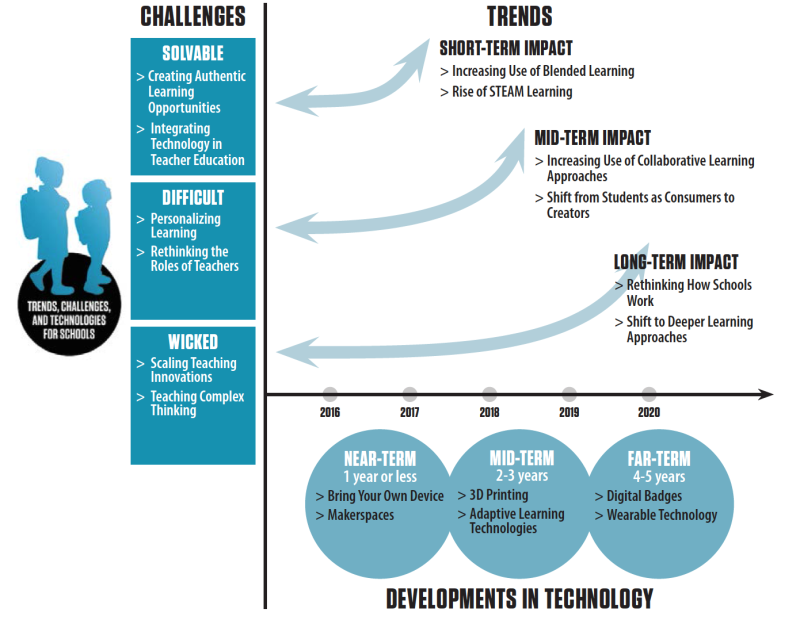Collaborations: In the next three to four years, experts see collaborative social learning and a move to transition students from consumers to creators as big trends in education technology. Educators have long known learning is a social process -- when teachers and students create meaning together, often the results are much more effective. The NMC Horizon report highlights four principles of collaborative learning: “placing the learner at the center, emphasizing interaction and doing, working in groups, and developing solutions to real-world problems.” Working in this way necessarily pushes students to create solutions, rather than passively consume content, lectures and lessons handed out by teachers. Access to mobile technology especially has helped students feel comfortable in the role of digital creator.
Blended Learning: Blended learning, or the use of technology alongside in-person instruction from a teacher, has been included in the NMC Horizons report before. Now, experts see it as a short-term trend that is quickly becoming common in many classrooms and is driving many efforts to integrate technology. STEAM programs, in which teachers integrate the arts and humanities into teaching about science, technology, engineering and math, is also a short-term trend driving technology.
CHALLENGES
Authentic Learning: As with any changing industry, there are many problems standing in the way of effective technology implementation. Some problems are already being solved in creative ways by educators setting an example of the way forward, while others are more difficult and haven’t yet been solved. One challenge that persists in mainstream education is how to create truly authentic learning opportunities within the bureaucracy of schools. As with other education buzzwords, many schools believe they are providing authentic learning, but they don’t offer the apprenticeships, vocational training and portfolio-based assessments that often characterize work that carries larger life lessons.

Professional Development: Another challenge being met in some places is how to incorporate technology into teacher-training programs. When teachers don’t use technology in their classrooms, it’s often because they don’t feel comfortable with it or don’t see how it enhances their teaching. Exposure during teacher training would help seed good practices early and ingrain digital literacy as an important skill for students to learn. As things stand now, many teachers receive professional development around technology platforms that often turn over or are replaced by something else. The report notes, “This challenge is exacerbated by the fact that digital literacy is less about tools and more about thinking, and thus skills and standards based on tools and platforms have proven to be somewhat ephemeral.”
Personalized Learning & Teacher's Role: Two of the much more difficult challenges facing tech integration are effective strategies for personalizing learning and reevaluating the role of teachers in education. These two challenges go hand-in-hand, as they require a complete re-engineering of the school experience, rather than tinkering around the edges of traditional school. Many school leaders believe that by using technology and adaptive software to allow students to move at different paces, they are offering “personalized learning.” But the experts behind this report caution that, “this approach may be indicative of personalized learning solutions being sold to schools as a mass commodity that helps them raise standardized test scores, ultimately missing the goal of making learning a more meaningful experience.”
The value in “personalized learning” lies in student autonomy and individualized instruction and support, not in the control and compliance model required to achieve high test scores. If this more radical and child-centered definition of “personalized” is to be achieved, the role teachers play also need reimagining. With online interactions facilitating collaboration for both students and teachers, and learning taking place at all times of the day online and off, a lot is being asked of teachers. Their guidance is no longer confined to school hours.
The report points out that teachers are no longer information distributors, but their new role has not always been well defined or supported by education leaders and policymakers:
“In ideal situations, the teacher’s role is becoming that of a mentor, visiting with groups and individual learners during class to help guide them, while allowing them to have more of a say in their own learning. However, these types of interactions and the enabling use of technology are not always inherent or sufficiently integrated in pre-service training.”
Scalability: The really thorny challenges -- those that are “complex to define, let alone address" -- provide food for thought. Experts identified scaling innovative technologies and approaches as one intractable dilemma. Educators are familiar with the frustration of trying to break through rules and bureaucracy to experiment with innovative ideas. While inspiring teaching is happening all over the world, in many cases it does so in pockets, due to the tireless work of a dedicated educator, and not as part of mainstream education.
A similarly tricky problem lies in how to teach students the complex thinking skills that will be required to nimbly move through future challenges. One way educators are trying to cultivate these skills is through computer science and coding. However, coding alone won’t solve all the problems of the world, and as long as traditional school remains siloed into discrete subject areas, it will be difficult to allow students opportunities to tackle truly complex problems.
DEVELOPMENTS IN ED TECH
BYOD/Maker Movement: In just one or two years, experts predict Bring Your Own Device policies and makerspaces will be commonplace in schools. A 2014 Consortium for School Networking (CoSN) survey found that 81 percent of surveyed schools either had a BYOD policy or planned to implement one. These policies reflect the reality of students’ lives and can also cut down on school technology costs. Similarly, the popular Maker Movement and increasing emphasis on hands-on learning has propelled school makerspaces into the limelight. School leaders see these spaces as a way for students to take initiative: designing, prototyping and building their ideas from start to finish.
3-D Printing: The report notes that in the next two to three years, 3-D printing and adaptive learning technologies will have become mainstream school technologies. Experts believe 3-D printing offers tremendous opportunities for students to explore objects and concepts that might be difficult to experience in school. The printer can help students visualize mathematical graphs and models or touch replicas of historic artifacts. Low-cost online design tools and cheaper machines are helping to make 3-D printing accessible to schools, while project-based pedagogy is making it popular.
Adaptive Learning: Adaptive learning refers to software that adjusts to students’ learning needs as they use the product. Increasingly, this kind of software is being used to allow each student to move at his or her own pace. The idea is tremendously appealing to some education leaders, while others worry that relying on software to recognize student needs will actually diminish the personalized attention from an educator that each student deserves.
While the authors of the NMC Horizon report feel adaptive learning could soon be a game changer, they caution that the software may not be sophisticated enough yet to meet educators' dreams. Instead, the authors posit its best use may be to analyze macro-level data on the effectiveness of curriculum and instruction.
Badges and Wearables: On the long-term horizon, experts see digital badges and wearable technology as important technology developments in four to five years. Badges are already being used to recognize competence in a skill in digital spaces like Khan Academy. Increasingly, schools are looking to badges as a way to validate informal learning for both students and teachers. While not yet pervasive, badges could offer a more comprehensive way to certify learning opportunities, inside and outside of school.



